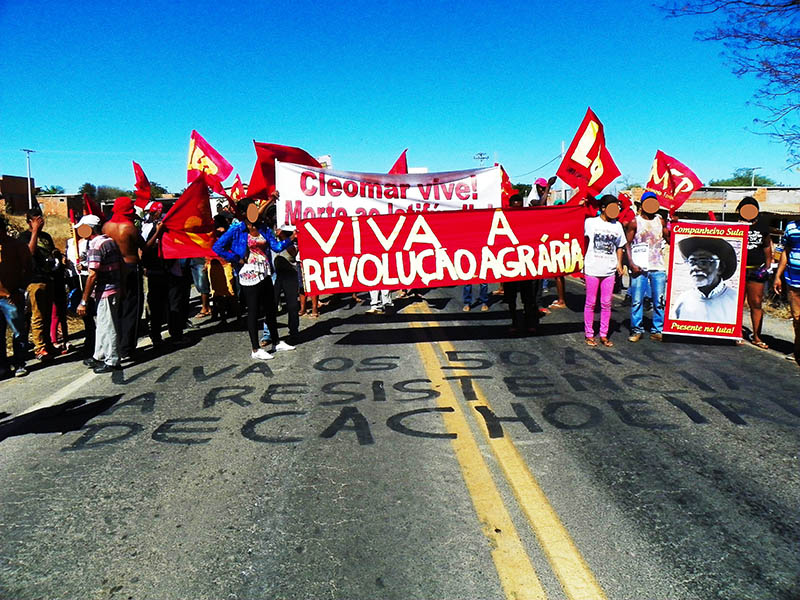Only in 2017, three massacres and 60 murders took place in the countryside of Brazil and this expresses the sharpening of the reactionary civil war in the countryside. The amazonian region was stage of most of these murders and also two of the massacres: Pau D’Arco, in Pará, and Colniza, in Mato Grosso. Despite this, the masses keep resisting and advancing in their struggle.
According to the data of the CPT (commission of the Shepherds of the land) in 2016 there were 1079 registered conflicts for land and territory and in 2015 this number was 771. Only in the amazonian region in the last years 980 agrarian conflicts involving 98.400 families against the latifundium are registered in the “Atlas of the Conflicts in Amazônia” made by the CPT. 197 conflicts in Maranhão (20,1%), 191 in Rondônia (19,5%), 142 in Pará (14,5%), 135 in Tocantins (13,8%) and 97 in Mato Grosso (9,9%). The amazonian region, between 1985 and 2009, was stage of 63% of the total of murders in the countryside, 39% of the families displaced by private powers and had 52% of the arrested peasants from the total in the country.
Comparing the different fractions managing the old State, we see that there is no difference in the repression of the people in the countryside. Temer/PMDB management was responsible for at least 100 murders, 35 in the second half of 2016 and 65 in 2017, during the management of Luiz Inácio/PT there was 305 murders in the period between 2003 and 2010 and in the first year of his mandate there was 73 murders, the highest registered number in the data of CPT, which registers data since 1985. In Dilma/PT management there was 185 murders in the countryside in the period of 2011 to 2015. The Worker’s Party did not eased the violence situation in the countryside, but deepened it, worked in favor of the landlords and agribusiness, expanded it into Amazônia. During the management of Fernando Henrique Cardoso/PSDB 292 murders were registered from 1995 to 2002, this period was marked by an increase in the reactionary war in the countryside and was also the period in which the Heroic Battle of Santa Elina took place, where the military police together with henchmen of the landlords assaulted the peasant occupation in Santa Elina farm in Corumbiara, Rondonia, and also the massacre of Eldorado do Carajás, in Pará.

Repression and torture by the military police against the peasant who survived the Heroic Battle of Santa Elina in 1995.
Among the reasons for the conflicts in the countryside, the Atlas of CPT points out some of them in the document, such as the lack of access to land for peasants, indigenous and quilombola peoples, the bankruptcy of the agrarian reform and the demarcation of indigenous and quilombola peoples territory, the actions of the latifundium and agribusiness in search of natural resources (water, wood, ore, etc.), the attempts of “grilagem” (forged documents of land property) of the property of the State, the impunity of the crimes against the workers which the culprits are never judged or condemned, the actions of the judiciary which is quick to make repossession mandates and slow to regularize the lands for the agrarian reform, the policies and laws that attacks and remove rights from the workers of the countryside and the repressive intervention of the different police departments and Armed Forces, the conflict between the environmental departments and the peoples of the countryside, the departments responsible for marking the territories of the indigenous and quilombola peoples as well as the department responsible for agrarian reform are characterized by omission, passivity and inertia and the creation of “associations of rural producers” by the landlords which serves as a facade for their criminal actions in organizing and sponsoring crimes against the workers of the countryside.
In this scenery of reactionary civil war, the peasant masses – mainly the poor peasantry with little or without land – can only take the path to the Agrarian Revolution to solve their problems, through mobilizing, organizing and politicizing the peasants in revolutionary violence, seizing the lands of the landlords, dividing the land themselves and immediately start producing, without waiting for the old State to do their bankrupt agrarian reform. And this is the way that each time more peasants are taking and will destroy latifundium in the end, opening the path for a New Democratic Revolution in Brazil.

Demonstration in Montes Claros, Minas Gerais against the crimes of the military management, in memory of the resistance of Cachoeirinha.
